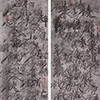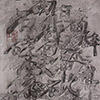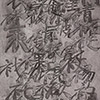Catalogue Note:
DICTIONARY SERIES: RADICAL STONE AND CLOTHES
QIU ZHIJIE
The surging art trends and movements since the 1980s began to crumble the absolute spirit of art. The utopian ideals in the world of art began to collapse. People continuously attacked the purposes, the moral meanings, the political intentions and the values of art. The ways and theories of artistic creation also became more and more liberal. In the mid and late 1980s, to maintain the speed of progress, radical artists began to head to the direction of antiart. In this background, performance art and conceptual art began to enter the minds of Chinese artists. As one of the earl iest contemporary Chinese artists who practiced conceptual art, Qiu Zhijie aroused discussions in the art circle with one of his early works, A One-thousand-time Copy of Lantingxu. He copied Lantingxu a thousand times until the paper was filled with black text. It was obvious that the artist intended to dissolve the cultural symbols in the course of copying. In his later creations, he still cont inued to contemplate on the relations between traditional culture and characters. The following is his explanation of his motive in creating the Dictionary series:
The 'Dictionary' series is made up by several scrolls with each scroll filled with the words of the same radicals. For instance, one s croll is written with 志 (will), 意 (meaning), 悲 (sadness), 愁 (sorrow), 願 (wish), 怨 (resentment), 惡 (evil), 思 (thought), 想 (idea), 怒 (anger) and other characters formed by the radical of 心 (heart). This scroll is covered with a variety of moods and mental states. Another scroll is written with 議 (comment), 說 (say), 詞 (word), 語 (language), 訴 (tell) and other characters formed by the radical of 言 (speech) , showing various ways of saying and speeches. The rest follows the Five Elements (wood, fire, earth, metal and water) and the other radicals referring to people, animals and nature. Instead of quoting poems and verses, I found a strange sense of pleasure in copying the dictionary and changing the content of my writing. Although the characters do not constitute Chinese idioms, the close relations of those characters, derived from the same radicals and families, naturally form special meanings. I found that 仙 (fairy) and 佛 (buddha) both share the same character, 人 (men). 伎倆 (maneuver) and 僂傴 (hunchback) come from the same family, which left me a moment of realization that one can be the company as well as the enemy when pictograms become the book of revelation.
When a certain amount of characters of the same radicals are juxtaposed, the image and conceptual system of Han culture emerged from the paper. Chinese calligraphy unexpectedly turned its field from literature to philosophy. When eliminating unnecessary emotional disturbance and returning to the most physical status of writing,' I naturally entered the most metaphysical realm. Special content demands special materials and techniques. I used Japanese shoji paper, which can endure repeated scratches and washes, to repetitively copy the characters and wash the paper and eventually form a kind of special layered effect. Viewers may abandon linear views and watch the scroll randomly, freely appreciating the work without beginning or end.
QIU ZHIJIE
The surging art trends and movements since the 1980s began to crumble the absolute spirit of art. The utopian ideals in the world of art began to collapse. People continuously attacked the purposes, the moral meanings, the political intentions and the values of art. The ways and theories of artistic creation also became more and more liberal. In the mid and late 1980s, to maintain the speed of progress, radical artists began to head to the direction of antiart. In this background, performance art and conceptual art began to enter the minds of Chinese artists. As one of the earl iest contemporary Chinese artists who practiced conceptual art, Qiu Zhijie aroused discussions in the art circle with one of his early works, A One-thousand-time Copy of Lantingxu. He copied Lantingxu a thousand times until the paper was filled with black text. It was obvious that the artist intended to dissolve the cultural symbols in the course of copying. In his later creations, he still cont inued to contemplate on the relations between traditional culture and characters. The following is his explanation of his motive in creating the Dictionary series:
The 'Dictionary' series is made up by several scrolls with each scroll filled with the words of the same radicals. For instance, one s croll is written with 志 (will), 意 (meaning), 悲 (sadness), 愁 (sorrow), 願 (wish), 怨 (resentment), 惡 (evil), 思 (thought), 想 (idea), 怒 (anger) and other characters formed by the radical of 心 (heart). This scroll is covered with a variety of moods and mental states. Another scroll is written with 議 (comment), 說 (say), 詞 (word), 語 (language), 訴 (tell) and other characters formed by the radical of 言 (speech) , showing various ways of saying and speeches. The rest follows the Five Elements (wood, fire, earth, metal and water) and the other radicals referring to people, animals and nature. Instead of quoting poems and verses, I found a strange sense of pleasure in copying the dictionary and changing the content of my writing. Although the characters do not constitute Chinese idioms, the close relations of those characters, derived from the same radicals and families, naturally form special meanings. I found that 仙 (fairy) and 佛 (buddha) both share the same character, 人 (men). 伎倆 (maneuver) and 僂傴 (hunchback) come from the same family, which left me a moment of realization that one can be the company as well as the enemy when pictograms become the book of revelation.
When a certain amount of characters of the same radicals are juxtaposed, the image and conceptual system of Han culture emerged from the paper. Chinese calligraphy unexpectedly turned its field from literature to philosophy. When eliminating unnecessary emotional disturbance and returning to the most physical status of writing,' I naturally entered the most metaphysical realm. Special content demands special materials and techniques. I used Japanese shoji paper, which can endure repeated scratches and washes, to repetitively copy the characters and wash the paper and eventually form a kind of special layered effect. Viewers may abandon linear views and watch the scroll randomly, freely appreciating the work without beginning or end.



